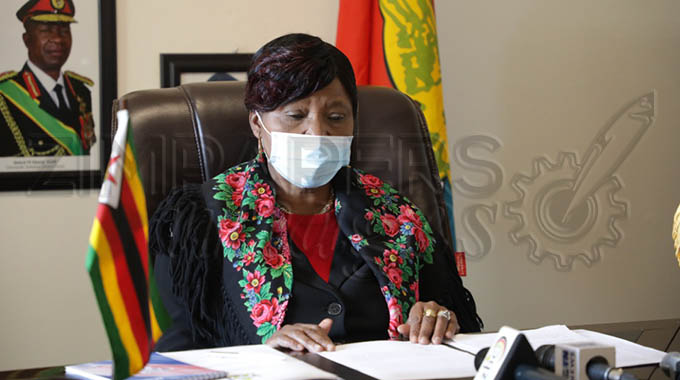Another bumper agric season beckons

Sifelani Tsiko–Agric, Environment & Innovations Editor
Normal to above normal rainfall is most likely during the next summer rains over most of SADC region, according to a seasonal forecast from the 25th Southern African Regional Climate Outlook Forum (SARCOF 25) released yesterday.
More detailed information on likely Zimbabwean rainfall patterns and discussion on these forecasts comes today with the National Climate Outlook Forum hosted by the Meteorological Services Department, Environment, Climate, Tourism and Hospitality Acting Minister Oppah Muchinguri-Kashiri told Cabinet yesterday.
Speaking after the Cabinet meeting, Information, Publicity and Broadcasting Services Minister Monica Mutsvangwa said the national forum provided a platform for the sharing of information on forecasts and outlooks for the upcoming rainfall season for all-stakeholders.
The seasonal rainfall outlook is considered a critical planning tool that helps farmers select the right varieties and even the right crops to plant, depending on what can be expected in their area.
While the regional forum of experts from across SADC gives the consensus over large areas, the National Climate Outlook Forum gives more detailed forecasts and the outlooks for each area.
Zimbabwe is divided into three regions and all three are now expected to have generally normal to above normal rainfall. Detailed information will be provided by the Meteorological Services Department of Zimbabwe from time to time
In the SADC report, normal to above-normal rainfall has been forecast during the three months from October to December this year, the first half of the season, but normal to below normal rainfall is likely in an arc along the Atlantic and into the north of the region, the area encompassing north-western Angola, most of Democratic Republic of Congo, western and southern Madagascar, northern Malawi, northern Mozambique, the western fringes of Namibia and South Africa, and south-western Tanzania and north-eastern Zambia.
SARCOF-25 was held virtually from August 30 to 31 to generate a consensus outlook for the forthcoming summer rainy season over SADC.
Zimbabwe is in the area likely to receive normal to above normal rains in both halves of the season. This is for the second consecutive season that Zimbabwe and much of the region in general are likely to see better rains after most of SADC saw at least adequate rains last summer season.
One of the major drivers of the forecast by regional climate experts is the greater chance of a La Nina weather system in the central Pacific Ocean, a weather event normally associated with wetter conditions in Southern Africa.
A La Nina tends to see cooler conditions in the tropical waters of the eastern Pacific as warmer water is pushed west. It is the opposite of an El Nino which sees a warm equatorial Pacific current flowing east.
Climate experts further said that La Nina events are also associated with heightened risk of flooding and cyclones as well as cooler daytime temperatures in this part of the world.
Adequate rains forecast for the coming season will have a positive impact on agriculture, water resources and hydropower generation in most of the region. Good rains in eastern Angola guarantee good flows into Lake Kariba for power generation.
For Zimbabwe, improved rains this coming season are likely to further replenish ground and dam water resources bolstering water, food and energy security for the country.
SADC climate experts broke down the region into 12 zones covering the main southern African sub-continent as well as the island region on the Indian ocean.
In the first half of the rainy season, there are increased chances of normal to above-normal rainfall in the zones covering northern DRC, northern Tanzania, northern Mozambique, southern Tanzania, northern Malawi, northernmost Zambia, bulk of DRC and north-western part of Angola, Central Mozambique, southern Malawi, northern half of Zimbabwe, most of Zambia, southernmost DRC, south-eastern half of Angola, bulk of Namibia, western half of Botswana, most of central and western parts of South Africa and western parts of Lesotho, extreme south-western Zambia, Caprivi area of Namibia, south-easternmost Angola, south-western Zimbabwe, eastern half of Botswana, most of northern South Africa, eastern Lesotho, Eswatini, and southern Mozambique.
However, Zone 6 which includes south-western Angola and western coastal areas of Namibia and western fringes of South Africa, has increased chances of normal to below-normal rainfall.
In the Indian Ocean, western Madagascar is likely to receive normal to below-normal rainfall while the eastern side of this island nation will get normal to above-normal rainfall. Southern Madagascar has increased chances of normal to below-normal rainfall while other island countries that include Mauritius, Seychelles and the Comoros will receive normal to above-normal rainfall.
In the second and final half of the rainfall season, experts forecast normal to above normal rains for the zones covering the bulk of DRC and northernmost Angola, northern Mozambique, bulk of Tanzania, northern Malawi, northern and western Zambia, bulk of Angola, south eastern DRC, north-western tip of Botswana and northernmost Namibia, the western half of Botswana, central to southern Namibia, western Lesotho and central South Africa, central Mozambique, southern Malawi, central Zambia, northern half of Zimbabwe, southern Mozambique, southern half of Zimbabwe, eastern half of Botswana, central and northern South Africa, Eswatini and eastern Lesotho.
Regional climate experts also examined the potential impact of the wetter season forecast in the coming summer rainy season.
The normal to above normal rains were likely to bring outbreaks of locusts, armoured crickets and the fall armyworm and experts said countries in the region should plan and intensify surveillance of pests to minimise damage to crops.
Last season, there were locust outbreaks in Zimbabwe, Botswana, Namibia and Zambia which required the authorities in these countries to take more steps to control pests.
Experts urged member states to plan ahead for emergency locust response and preparedness programmes.
Flooding, cyclones and leaching were also likely in this coming season and experts said countries should encourage areas which were vulnerable to put in proper drainage measures, do contouring for ridging to protect crops and assist with drainage and canals.
“Strategies should be devised and implemented for managing leaching, which is the loss of valuable fertiliser applications.
“Excessively wet conditions due to incessant rains can negatively affect crop growth due to leaching of nutrients, especially nitrogen, from the soil. Heavy rains could increase chances of waterborne diseases such as malaria and cholera, increased livestock diseases and other public health problems,” noted the Forum.
More cyclones tend to be seen in La Nina years, but the worst to hit Zimbabwe in half a century, Cyclone Idai at the end of the 2018-19 season occurred in an El Nino year.
And the Sadc climate experts warned that member states should not be complacent as the region is likely to experience an average or above-average number of tropical cyclones this season.
Tropical Cyclone Idai, the worst in more than 50 years, brought heavy rainfall and strong winds to Malawi, Mozambique and Zimbabwe between March 5 and 19 2019, causing severe flooding which led to loss of lives, destruction of infrastructure, disruption of livelihoods and destruction of crops.
Countries were urged to conduct public education and awareness campaigns and set up areas for temporary shelter in case of flooding and cyclones.
“The season forecast presents an opportunity to put aside resources for the occurrence of extreme events,” said Chandapiwa Sebeela, director of the Botswana Department of Meteorological Services.
“Countries need to avail more resources for disaster risk management and response,” he noted.









Comments